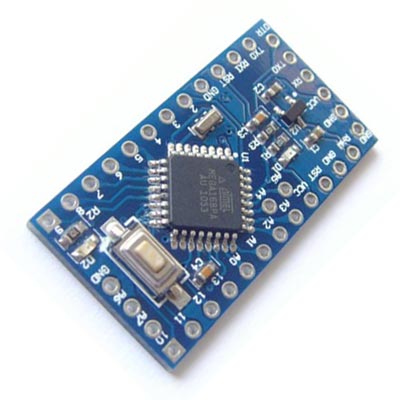

You can power the board using the DC jack and by applying a voltage between 7 and 12V to the Arduino, which powers the other components via the 5V VCC.
#USING ARDUINO PRO MINI DOWNLOAD#
For the SD card reader, I used the “SdFat” library, because the standard SD libraries from Arduino didn’t work that well | Click Here To Download Sdfat Library Then, we can use the milis() function to store the time passed, and multiply it with the power, in order to calculate the energy that has been used. Furthermore, we multiply current with the voltage in order to obtain the power used. For that, I made voltage dividers out of resistors to drop the 5V signals to appropriate 3.3V signals for the chip (MOSI, CS and CLK lines respectively and to drop down the 5V to 3.3V to power the module).įinally, we program the Arduino using the Adafruit library for the INA219 module, to read the voltage and current values. This module is not 5V compatible, so we cannot just wire it up to the Arduino interface since the 5V will destroy the 3.3V chip. This module communicates via an SPI interface, which also uses commands to write/read data. A micro SD card reader, in order to store the measured data as text files, from where you can copy them into a program like Excel to make nice looking plots, and calculate the power and energy used, by multiplying the current and voltage with the time respectively. Now, to make this project complete, we will add a final component. We can use the already made Adafruit library once again in order to send data we want to show on the display | Click Here To Download Adafruit library | you will also need the Adafruit GFX library. I have been working with the “96 inch OLED display for a while now, and it works beautifully. This way we can actually display the values we’re measuring. The next component which I will be using is a display. There are libraries from Adafruit which you can download, and use premade functions to read the voltage and current | Click Here To Download Library We are lucky again because we don’t have to go through that trouble. This IC offers an I2C interface, to communicate with the Arduino, and by studying the datasheet, we can use specific commands over the I2C interface, in order to read the voltage and current values. For this project, I will be using an INA219 IC, which uses a 0.1R resistor as a shunt and can measure voltages up to 32V, and has a current range of 0-3.2A.

Luckily, there are modules out there, which make our lives easier. Now, this method is rather crude, and it works only for voltages within 0-5 V, and the ADC of the Arduino which is used to read the voltage drop of the resistor is a bit inaccurate for measuring hundreds of mV only which will drop across the shunt. You use the analog input to measure the voltage across the load and use a shunt to measure the current via the voltage drop of the shunt resistor. If you wanted to measure voltage and current of a circuit with an Arduino, the procedure is pretty straight forward. Hello, electronics community! Today I will present you a project which lets you measure the voltage and current of an appliance, and display it together with the power and energy values.


 0 kommentar(er)
0 kommentar(er)
